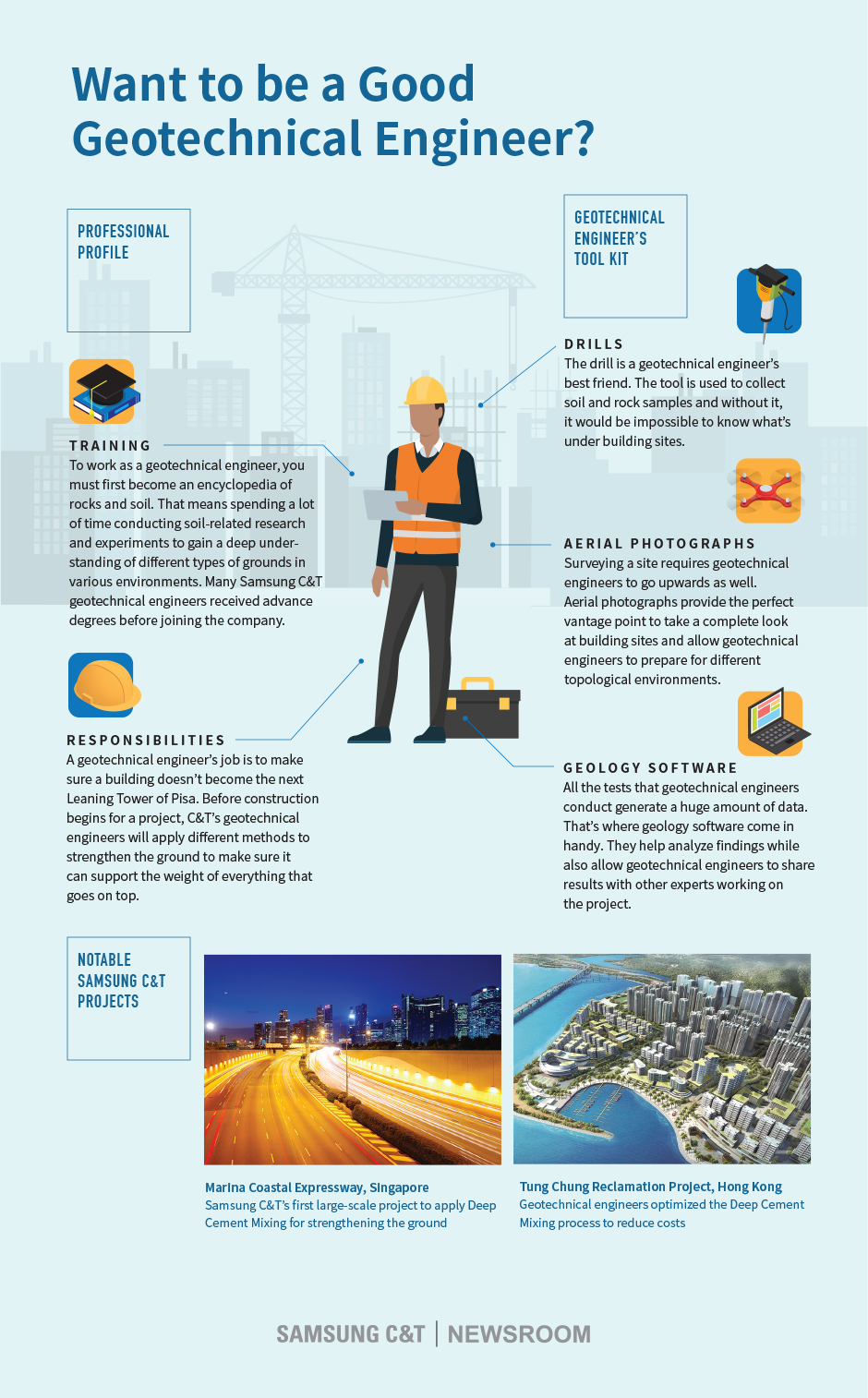The Main Principles Of Geotheta
The Main Principles Of Geotheta
Blog Article
The smart Trick of Geotheta That Nobody is Discussing
Table of ContentsGeotheta for BeginnersThe Facts About Geotheta RevealedSome Known Details About Geotheta Things about GeothetaThe 20-Second Trick For Geotheta

They conduct site investigations, gather examples, execute laboratory examinations, and evaluate information to review the suitability of the ground for construction jobs - Engineer of Record. Based upon their searchings for, geotechnical designers supply suggestions for structure layout, incline security, preserving frameworks, and mitigation of geotechnical hazards. They collaborate with various other professionals, such as architects, structural designers, and construction groups, to make certain that geotechnical considerations are integrated into the total project layout and execution
By examining the behavior and homes of dirt and rock, they can determine prospective geotechnical risks such as landslides, soil negotiation, or slope instability. Their know-how assists protect against failings or crashes that could endanger lives and home. Below are some comprehensive obligations and duties of a geotechnical designer: Website Examination: Geotechnical designers conduct site investigations to collect information on subsurface conditions.
They analyze the information to understand the buildings and actions of the dirt and rock, including their strength, permeability, compaction characteristics, and groundwater conditions. Geotechnical Evaluation and Design: Geotechnical designers evaluate the information accumulated during website examinations to examine the security and suitability of the site for building and construction projects. They perform geotechnical calculations and modeling to assess variables such as birthing capability, settlement, incline stability, lateral planet pressures, and groundwater circulation.
The 7-Minute Rule for Geotheta
Structure Style: Geotechnical engineers play an important role in designing structures that can securely sustain the intended structure. They assess the soil problems and load needs to figure out the proper structure kind, such as shallow structures (e.g., footings), deep structures (e.g (https://realistic-swam-lvtf1k.mystrikingly.com/blog/unlocking-the-secrets-of-geotechnical-engineers-the-geotheta-advantage)., heaps), or specialized techniques like soil renovation. They take into consideration elements such as negotiation limitations, birthing capability, and soil-structure interaction to establish optimal structure designs
They assess building plans, monitor website activities, and conduct area evaluations to verify that the design recommendations are followed. If unanticipated geotechnical concerns emerge, they evaluate the situation and supply suggestions for removal or changes to the design. Threat Assessment and Mitigation: Geotechnical designers evaluate geotechnical threats and risks connected with the project website, such as landslides, liquefaction, or soil disintegration.

Collaboration and Communication: Geotechnical designers function very closely with other professionals associated with a task, such as architects, structural designers, and building groups. Effective communication and partnership are vital to integrate geotechnical considerations right into the overall job design and construction procedure. Geotechnical designers give technical know-how, solution inquiries, and make certain that geotechnical needs are satisfied.
Geotheta - Questions
Here are some kinds of geotechnical designers: Foundation Engineer: Foundation designers specialize in creating and examining foundations for frameworks. They evaluate the dirt conditions, lots demands, and site characteristics to figure out the most ideal structure type and style, such as superficial structures, deep structures, or specialized methods like stack structures.
They examine the elements influencing slope security, such as dirt residential properties, groundwater conditions, and slope geometry, and develop strategies to stop slope failings and minimize threats. Earthquake Engineer: Earthquake engineers concentrate on evaluating and making frameworks to withstand seismic forces. They evaluate the seismic hazard of a website, assess dirt liquefaction capacity, and create seismic style standards to ensure the safety and security and resilience of structures throughout quakes.
They carry out field screening, accumulate examples, and examine the gathered information to identify the dirt buildings, geologic developments, and groundwater conditions at a website. Geotechnical Instrumentation Engineer: Geotechnical instrumentation engineers concentrate on tracking and gauging the behavior of soil, rock, and frameworks. They install and keep instrumentation systems that monitor aspects such as dirt negotiation, groundwater degrees, slope motions, and architectural displacements to examine performance and supply very early cautions of potential issues.
The Definitive Guide to Geotheta
They conduct tests such as triaxial examinations, loan consolidation examinations, straight shear examinations, and permeability tests to gather information for geotechnical analysis and layout. Geosynthetics Designer: Geosynthetics designers focus on the layout and application of geosynthetic products, such as geotextiles, geogrids, and geomembranes. They make use of these materials to improve soil stability, strengthen slopes, provide water drainage remedies, and control erosion.
They often tend to be investigatory people, which suggests they're intellectual, reflective, and analytical. They are interested, methodical, logical, analytical, and logical. Some of them are also social, indicating they're kind, generous, participating, person, caring, useful, empathetic, sensible, and pleasant - Geo Tech Engineer.
In the workplace setting, geotechnical engineers utilize specialized software tools to execute computations, produce designs, and evaluate information. They prepare reports, testimonial project specifications, connect with customers and team members, and coordinate project activities. The workplace setting gives a helpful setting for research, evaluation, and collaboration with various other experts associated with the job.
Geotheta - The Facts
They frequently check out project websites to perform website examinations, examine geotechnical problems, and collect data for evaluation. These visits entail traveling to different places, in some cases in remote or difficult terrains. Geotechnical engineers might execute dirt sampling, conduct tests, and display building and construction activities to make sure that the geotechnical facets of the task are being executed properly.
Geotechnical designers additionally function in specialized geotechnical research laboratories. Geotechnical laboratory engineers function extensively in these environments, managing testing equipment, running tools, and videotaping data.
Report this page